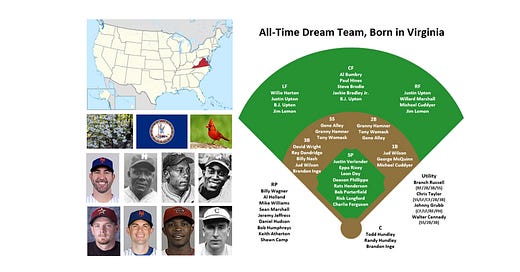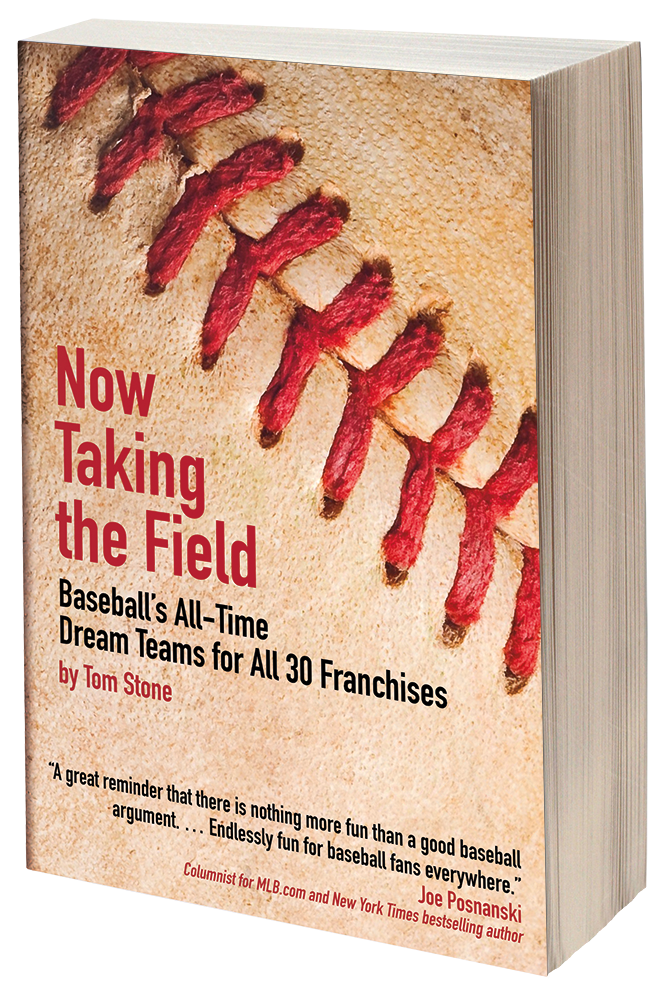Virginia's Baseball All-Time Dream Team
What would a dream team roster look like for major league players born in Virginia?
Issue #102
This is the 12th article in a series where I am creating all-time dream teams for players born in each of the fifty US states. I’ll be publishing each write-up on the anniversary date that the particular state joined the union. So far I’ve covered Maryland, Louisiana, Minnesota, South Carolina, Rhode Island, Wisconsin, Kentucky, Tennessee, Arkansas, West Virginia, and New Hampshire.
Next up is Virginia, which was one of the original 13 colonies and on June 25th, 1788, became the tenth state to ratify the U.S. Constitution (according to Wikipedia.)
Important caveat to what follows: I’m creating these all-time dream teams based on the birthplace data available at baseball-reference.com. I realize this might mean some players will appear for a state’s all-time dream that seems odd, e.g., a player who was born in one state but lived there only briefly, while then spending most of his youth, or especially critical years playing baseball in high school in another state. So that is an important caveat to the below dream team roster—and I’ll discuss the players that I know went to high school in a state other than Virginia towards the end of this article (and vice-versa, those born elsewhere but who went to high school in Virginia.)
Here is the all-time dream team I came up with for players born in Virginia:
This is a pretty solid overall US State dream team. It has four Hall of Famers—SP Eppa Rixey and three Negro Leagues stars in 1B Jud Wilson, 3B Ray Dandridge, and SP Leon Day (who also was a great hitter and played some in the outfield and infield.) Also included are two pitchers that I think will eventually be Hall of Famers, SP Justin Verlander and RP Billy Wagner. Then assorted other stars as well, including guys like 3B David Wright, LF/RF Justin Upton, and LF/DH Willie Horton—though Horton is one of two players on this roster who grew up and went to high school elsewhere (in his case, Michigan.)
Beyond the many star players, there is a lot of position versatility on this roster. Several of the outfielders played two or all three of the OF spots during their careers, including Justin Upton who actually played more in LF than RF, but I listed as the starter in RF to maximize the overall outfield’s offense. I also included several utility guys who played various infield positions, including Chris Taylor who currently plays many positions for the Dodgers, plus two more Negro Leagues players, Branch Russell and Walter Cannady.
For the primary infielders, I’d say the corner spots are stronger than up the middle. At 1B there is Jud Wilson who was an outstanding hitter, and George McQuinn (1936-48) who was excellent defensively and (I was surprised to learn) an All-Star in seven seasons. Across the diamond at 3B we have NY Mets star David Wright, high-average hitter Ray Dandridge, and 19th century star Billy Nash, who had six seasons with 90+ RBI even while never hitting more than 10 HR a year.
Both Gene Alley and Granny Hamner played more SS than 2B, but Hamner played enough games at 2B that I decided to list him as the starter there. Tony Womack split his time evenly between SS and 2B and led the NL in steals each year from 1997-1999, but was a light hitter with only a 72 OPS+ (.273/.317/.356 during a high-offense era).
The catching spot has the father-and-son tandem of Randy Hundley, who was mostly known for his great defense, and Todd Hundley, who was mostly known for his power hitting. Brandon Inge was primarily a 3B but also did some catching, so provides added depth behind the plate.
There are a few other position players that I didn’t include but deserve a brief mention. Pete Hill was a star of the early Negro Leagues, playing from 1899-1925, with only his last few seasons in leagues that are today considered major leagues. And then three current players, 1B Nathaniel Lowe (Rangers) and his brother OF Josh Lowe (Rays), as well as 2B Brandon Lowe (no relation, but also on the Rays) could one day soon crack this dream team roster.
Starting lineups for this all-time dream team could look like this:
Against RHP:
Al Bumbry CF (L)
Jud Wilson DH (L)
David Wright / Ray Dandridge / Billy Nash 3B (R)
Justin Upton RF (R)
Willie Horton LF (R)
George McQuinn 1B (L)
Todd Hundley C (S)
Gene Alley / Chris Taylor SS (R)
Tony Womack 2B (L)
Against LHP:
Paul Hines CF (R)
Ray Dandridge / Billy Nash DH (R)
David Wright 3B (R)
Justin Upton RF (R)
Willie Horton LF (R)
Jud Wilson 1B (L)
Granny Hamner 2B (R)
Randy Hundley / Brandon Inge C (R)
Gene Alley / Chris Taylor SS (R)
Al Bumbry just about always led off during his career, and Paul Hines was a 19th century star who hit .302 with some speed, so they make a good platoon in CF at the top of these lineups. Jud Wilson of course needs to play every day here, but I wanted to get George McQuinn’s glove in some games at 1B, so listed Wilson as the DH against RHP. Against lefties I’ll give the DH duties to Ray Dandridge and Billy Nash, who otherwise are fighting with David Wright for playing time at 3B.
As I noted earlier I shifted Justin Upton over to RF so that Willie Horton could get the starting nod in LF. Hamner played more SS than 2B, but there is a platoon option at 2B with Hamner and Womack, allowing Alley and Taylor to split the playing time at SS. And at Catcher I went with the younger Hundley and his power bat against RHP, but since even as a switch-hitter he didn’t hit lefties very well, I slotted the elder Hundley and his good glove, along with Inge, as the catchers against LHP.
As for pitchers, Verlander is clearly the ace of this staff. Someday he’ll join Eppa Rixey (1912-1933) and Negro Leagues star Leon Day (1934-1946) in the Hall of Fame. After those three, I went with Deacon Phillipe (1899-1911) who pitched all but his first season for the Pirates, won 20+ games six times with an impressive 189-109 (.634) career record, and had a 2.59 ERA and 119 ERA+.
Rounding out the starting five I think should be Negro Leagues pitcher Arthur Chauncey “Rats” Henderson who pitched from 1923-1931 in leagues that today are considered to be major leagues. His stats at baseball-reference.com show a 3.61 ERA and impressive 127 ERA+.
After those five you could debate who else should have been included, or how to rank them, but I went with Bob Porterfield (1948-59) who won 22 games in 1953 and was an All-Star the following season; Rick Langford (1976-1986) who won 19 games in 1980 while leading the AL in complete games and IP; and then old-timer Charlie Ferguson (1884-87) who was off to a good start with a 99-64 (.607) record, 2.67 ERA, and 120 ERA+, before he died of Typhoid Fever in 1888.
The bullpen is led by seven-time All-Star Billy Wagner and his 422 saves (currently 6th all-time), 11.9 career SO/9 ratio, 2.31 ERA, and very impressive 187 ERA+. I support him getting into the Hall of Fame, and with 68.1% of the vote earlier this year, hopefully he’ll reach the required 75% level next year.
Two others that I included were closers for at least parts of their careers, Al Holland (1977-87) who had 25 saves in 1983 and 29 saves in 1984, and Mike Williams (1992-2003) who had some rocky seasons, but also posted 20+ saves five times with a high of 46 in 2002. How to rank the rest of the relievers that I included could certainly be debated, as well as whether to include a few more that I left off.
To wrap up, here are the two Virginia-born players who I could determine went to high school in other states—and so are more associated with those states than Virginia:
Willie Horton = Michigan
Todd Hundley = Illinois
What about the other direction—born elsewhere but went to high school in Virginia? There were many such players, with the following being ones that might have had good enough careers to crack a different version of the above All-Time Virginia Dream Team:
2B Lou Whitaker - born in New York
3B/1B Ryan Zimmerman - born in North Carolina
3B/1B Mark Reynolds - born in Kentucky
SP Atlee Hammaker - born in California
SP Clay Kirby - born in Washington, DC
RP Javier López - born in Puerto Rico
If the dream team were based on where the players went to High School, then losing Horton would mean Justin Upton would get listed at his primary position of LF. The catching corps would take a hit by losing Todd Hundley, leaving only Randy Hundley and Brandon Inge. But 2B would be significantly upgraded with Lou Whitaker as the starter, and you wouldn’t really lose much offense overall since Ryan Zimmerman would be added to the roster as a reserve corner infielder. Javier López pitched in 839 games from 2003-16, ending up with a 3.48 career ERA and 121 ERA+, so he’d be in the bullpen mix for sure. And I could see Hammaker or Kirby possibly replacing Langford or Ferguson amongst the SP I included.
All data is from Baseball-Reference.com, and also their subscription service Stathead.com. If you are a big sports fan, be sure to check out the latest features at Stathead and the Sports Reference family of sites. The state map, flag, flower, and bird images are from Wikipedia.
Did you know? I wrote a book with the same title as this Substack newsletter / blog: Now Taking the Field: Baseball’s All-Time Dream Teams for All 30 Franchises. It was published in early 2019, by ACTA Sports, the publisher of the annual Bill James Handbook and other popular titles. You can learn more about it at www.NowTakingTheField.com, or buy directly at Amazon and other booksellers.






